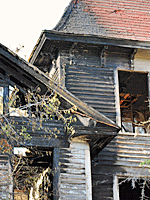 Late one night, when we were all in bed,
Late one night, when we were all in bed,
Mrs. O’Leary lit a lantern in the shed.
Her cow kicked it over,
Then winked her eye and said,
“There’ll be a hot time in the old town tonight!”
The Clark-Worley House was built about ten years after the Great Chicago Fire in October of 1871, and although the City of Chicago came together to rebuild what developed into one of the most populous and economically important American cities, the future for Clark-Worley House is grim.
Even though the house, located at 212 West King Street, is a landmark for some of us that have been here for 50 years or more, most people living in St. Augustine today know very little about the hundred year-old building that was badly damaged in the blaze in the wee hours of Monday morning.
And, the house is more commonly considered to be a “white elephant”, of sorts. It certainly would seem to be so for owner, Martin “Baby” Broudy. Misidentified in The St. Augustine Record as “Broudy’s Brothers Inc.”, Broudy Bros., Ltd., holds title to the Clark-Worley House and last year accumulated a $4,499.77 property tax bill for it — despite the fact that the structure has been boarded up for years.
Broudy also owns the adjacent property occupied by Broudy’s Liquor and the former Broudy’s Foodmart; which is also boarded up. Publically, Broudy has offered to give the Clark-Worley House away; if someone would pay the cost to move it. Broudy was denied the right to demolish the dilapidated remains because of a local ordinance that requires him to wait a year after making an application to do so.
After the Great Fire of St. Augustine, the Clark-Worley House will have to be razed — not because that isn’t what the owner has wanted to do all along, but, because, since the fire, the building is considered “dangerous”, according to City Building Official Nick Andrade. “The City never condemned the building and Mr. Broudy already had his demolition permit — subject to the required one year waiting period.”
I spoke with J. B. Coomes, President and owner of Coomes Oil & Supply, Inc., misidentified in the Guinta article published in The St. Augustine Record as “Coombs Oil”. Coomes is located across the street from the Clark-Worley House. Guinta wrote in his article that firefighters were “concerned” over a large tank full of heating oil and fuel nearby. Coomes told Historic City News that he never spoke to Guinta about that, and, had Guinta called, he would have told him, as he told us, that there was never any danger of his tanks burning or exploding from the actual fire. Coomes also told us that his tanks are never more than one-third full at any time — they are never “full of heating oil and fuel” as was reported.
I spoke with John Rayno who told me that he did not read The Record article about the fire, however, he confirmed that he had spoken to Senior Writer Peter Guinta. The Record reported, “Rayno said the cause of the fire would not be investigated”, and Rayno tells Historic City News that comment is misleading. Rayno explained that, as Fire Marshal and Assistant Fire Chief for the City of St. Augustine, when he got the page Monday morning, he actually went to the scene of the fire in person to investigate.
“I was able to determine the cause of the fire almost immediately,” Rayno said. “I found evidence of transients occupying the second level of the building and, in the southwest corner of that level, I determined the location where the fire began.” Rayno went on to say that he discovered evidence of burned candles that were consistent with the cause of the fire and that he is satisfied that his investigation is complete.
I asked Rayno about Coomes assessment that no danger was posed by his fuel oil tanks. Rayno told me that he would agree that residents in the Dancy Tract neighborhood were safe and that his comments to The Record should not be taken to mean otherwise. “We exercise an abundance of caution,” Rayno said, “The Chief made the determination to roll additional County tankers in case they might be needed.” The City Fire Department is only two or three blocks away from the Clark-Worley House and there is a City fire hydrant prominently located on the corner of King Street and Hartshorn Street; directly in front of the property.
So, it seems that, at last, the house that had been labeled by historic preservationists as “the most threatened historic building in St. Augustine,” due to its abandonment, age and deterioration, yet nobody would come forward to restore, will not be relocated — but rather demolished. And, what had become an unintended shelter for transients has finally succumbed to their carelessness.
Photo credit: © 2010 Historic City News staff photograph

